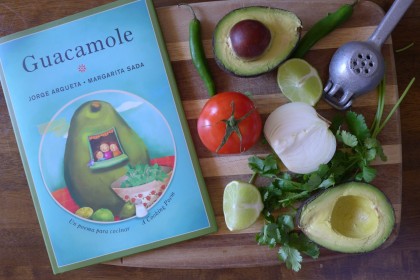- bilingual with full text in both English and Spanish
- a "cooking" poem
- 32 pages
“Guacamole” is a recipe poem written by Salvadoran poet Jorge Argueta. It is the third book in Argueta’s bilingual cooking poem series. His first two books, titled “Sopa de frijoles / Bean Soup”, and “Arroz con leche / Rice Pudding”, are structured similarly to “Guacamole. In all three, the poems’ verses span several pages, provide full text in both Spanish and English, and are accompanied by illustrations that enhance the text.
“Guacamole” is short, takes about seven to ten minutes to read aloud, and Mexican artist Margarita Sada’s accompanying oil-paint illustrations are as colorful and vibrant as the guacamole Argueta describes making. The illustrations are authentic in their depiction of the ingredients and materials needed throughout the poem, but use a much more round, cartoon feel when depicting everything else. By giving the family depicted a generic, light olive skin tone and brown hair, illustrator Sada remains true to the Spanish heritage that traditionally makes guacamole, while still making the book accessible to a wide variety of children reading and looking to see themselves in the illustrations:
One of the things I love about this book is that the title is the same in English and in Spanish: Guacamole. Thus, despite the poem being presented in two different languages, the finished product is one with which native speakers of either language can relate. Cooking is such a social part of families and culture that the idea of making food to bring one’s family together is one with which nearly all readers can identify. One of my favorite lines in "Guacamole" is when Argueta encourages this social aspect of cooking and tells the reader/cook to sing and dance as they taste, "because food tastes better / when you sing and dance." (Guacamole)
Because the poem is presented as a recipe rather than a more traditional story, there is a great deal of room for the reader to insert his or her own experience with cooking between the lines of the poem, and particularly of making guacamole. This can spark great discussion about why we cook for our families, who does the cooking, what ingredients we use, etc.
The language in “Guacamole” is, as one might expect, wonderfully poetic. Argueta describes the his ingredients in vivid language that really gets the reader hungry! For example:
“Sing to the salt
as you shake it
so that little spatters
of white drizzle
fall like rain on the green avocado.”
- "Guacamole"
The bottom line is that I suggest a visit to the grocery store before reading "Guacamole". The best way to read this book is like this:



No comments:
Post a Comment